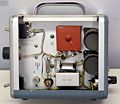108: Difference between revisions
No edit summary |
No edit summary |
||
| Line 7: | Line 7: | ||
The price in July 1959 was $125. The output is through an | The price in July 1959 was $125. The output is through an | ||
[[Connectors#N|N connector]]. | [[Connectors#N|N connector]]. | ||
Referring to the output network photo below, current flows in from the left | |||
through the 1K resistor, and charges the four red 0.1 uF capacitors that are in parallel. | |||
When the mercury switch (terminals visible at lower right) closes, the capacitors are | |||
suddenly connected to the output load of the pulse generator, causing a sharp step in the | |||
output voltage. The starting voltage of the step is typically 0V. The final voltage is | |||
adjustable, both in polarity and magnitude. The range is approximately -10V to 10V. | |||
<gallery> | <gallery> | ||
Revision as of 09:04, 15 October 2011
The Tektronix 108 is a 1ns-risetime pulse generator. It is the predecessor of the more complex and faster 109. Repetition rate of the 108 is 240 pps and the maximum pulse amplitude is 10Vpk into 50 Ohm load. It uses a mercury switch and selenium rectifiers. The price in July 1959 was $125. The output is through an N connector.
Referring to the output network photo below, current flows in from the left through the 1K resistor, and charges the four red 0.1 uF capacitors that are in parallel. When the mercury switch (terminals visible at lower right) closes, the capacitors are suddenly connected to the output load of the pulse generator, causing a sharp step in the output voltage. The starting voltage of the step is typically 0V. The final voltage is adjustable, both in polarity and magnitude. The range is approximately -10V to 10V.
-
-
-
-
Output network
-




